-
3-minute read
-
13th March 2017
Grammar Tips: Countable and Uncountable Nouns
The difference between countable (or count) and uncountable (or non-count) nouns can be confusing, especially if English isn’t your first language. But we’re grammar experts here at Proofed, so hopefully we can help.
Countable Nouns
As the name might suggest, countable nouns refer to things we can count (like the legs on a centipede, if we have enough time to count that many legs).

(Image: Yasunori Koide/wikimedia)
For singular countable nouns, depending on the context, we can use either the indefinite article (‘a/an’) or the definite article (‘the’).
And when we want to describe a non-specific number of a singular countable noun, we can use words like ‘some’, ‘few’ or ‘many’ depending on the rough quantity we have in mind.
|
Singular |
Plural |
|
One elephant |
Six elephants |
|
The apple |
The apples |
|
A month |
Some months |
|
An architect |
Many architects |
When we want to refer to a type of thing in general, it’s sometimes possible to omit the article or determiner altogether and use the plural countable noun:
Singular: The cat is lazy. (A specific cat)
Find this useful?
Subscribe to our newsletter and get writing tips from our editors straight to your inbox.
Subscribe to Beyond the Margins and get your monthly fix of editorial strategy, workflow tips, and real-world examples from content leaders.
Plural: Cats are lazy. (Cats in general)
Sleepy feline.Whether a countable noun is singular or plural also has an effect on the verb form. We use singular verbs for singular nouns:
The cat is chasing that poor mouse!
And plural verbs for plural nouns:
Hundreds of cats are chasing that poor mouse!
Although it’s becoming common to use ‘fewer’ and ‘less’ interchangeably, you should still use ‘fewer’ when referring to countable nouns in formal writing! Likewise, there is a formal difference between ‘amount’ (uncountable nouns) and ‘number’ (countable nouns).
Uncountable Nouns
Uncountable nouns refer to things that you cannot quantify by counting. A good example is ‘water’, since it would be unusual to say ‘There are a lot of waters in that bath’.
Unlike countable nouns, you cannot use the indefinite article (‘a/an’) with uncountable nouns (though you can use the definite article):
I enjoy swimming in cold water. (NOT I enjoy swimming in a cold water.)
The water is very cold!
To specify an amount of an uncountable noun, you can use a unit of measurement (e.g. ‘two litres of water’) or an appropriate determiner (e.g. ‘some honey’).
Don’t tell the bees we’ve taken it!In addition, since there is no plural form of uncountable nouns, they always take singular verbs in a sentence:
This milk tastes delicious! (NOT This milk taste delicious.)
In general, uncountable nouns are amorphous substances (e.g. ‘water’, ‘sand’), non-physical concepts (e.g. ‘passion’, ‘hate’) or other collective nouns (e.g. ‘luggage’).
Countable or Uncountable?
If you’re unsure about whether a noun is countable or uncountable, try using it with a number. For example, ‘five cars’ makes sense, so ‘car’ is a countable noun. On the other hand, ‘five sands’ sounds strange, so we know that ‘sand’ is an uncountable noun.